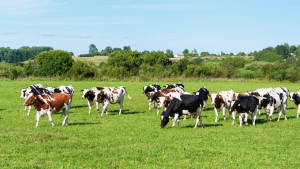
Technology on the farm isn’t new, but cow wearables have taken precision agriculture to the next level. If you’re considering this investment for your dairy operation, you’re probably wondering about the real costs, benefits, and whether it’ll actually improve your profitability. Let’s break down what New Zealand farmers are experiencing with these smart collars and ear tags.
The Numbers Game: What Are Cow Wearables Really Costing?
The investment range for cow wearable technology varies significantly depending on what system you choose. Currently, New Zealand farmers are looking at anywhere from $40 to $197 per cow per year for collar technologies. Here’s how the main options stack up:
- Basic monitoring systems (CowManager, Allflex): Around $40-80 per cow annually
- Advanced systems with virtual fencing (Halter): Recently reduced to $9.90 per cow per month ($118.80 annually)
- Premium integrated systems: Up to $197 per cow per year
For a typical 400-cow herd, you’re looking at an annual investment of $16,000 to $78,800, which is a significant line item in any farm budget.
The Hidden Infrastructure Costs
Here’s where many farmers get caught out – the wearables are just part of the equation. To maximise your return on investment, particularly for heat detection, you’ll likely need automated drafting gates costing $40,000 or more.
The numbers tell the story: around 60% of rotary sheds have installed drafting gates compared to only 20% of herringbone systems. This explains why rotary farms have three times the uptake rate for wearables. Without drafting capability, you’re essentially getting an expensive notification system that still requires manual sorting of animals.
Return on Investment: What the Data Shows
The good news is that when implemented properly, these systems can deliver genuine returns:
Reproductive Performance
Farms using Halter technology achieved a median 70.9% six-week in-calf rate, compared to the industry median of 66.8%. That 4.1% improvement might not sound dramatic, but for a 400-cow herd, it could mean 16 more calves and significantly reduced empty rates.
Labour Savings
The labour component is where many farms see immediate returns. Heat detection alone can save hours of tail painting and visual monitoring during mating season. For farms with skilled labour shortages – and let’s face it, that’s most of us – this technology can fill critical gaps.
Health Monitoring Benefits
Early disease detection translates directly to reduced treatment costs and minimized milk production losses. Farmers report picking up conditions like mastitis, ketosis, and milk fever much earlier, leading to faster recovery times and lower veterinary bills.
The Reality Check: It’s Not a Magic Bullet
Recent DairyNZ research analysing 141 herds with wearables against 1,150 without revealed some sobering truths. While the technology excels as a labour-saving tool, lower-performing herds showed no reproductive performance gains after adopting wearables.
This suggests that wearables amplify good management practices rather than fixing fundamental issues. If your farm already struggles with reproductive performance due to nutrition, genetics, or other management factors, the technology won’t be your silver bullet.
Making the Business Case
From an accounting perspective, here are the key financial considerations:
Cash Flow Impact
Most systems operate on monthly subscription models, spreading the cost but creating ongoing operational expenses. Factor this into your cash flow projections, especially during seasonal variations in milk income.
Depreciation and Tax Implications
The hardware components may qualify for depreciation benefits. Discuss with us how to structure the purchase to optimize your tax position, particularly if you’re considering a significant system upgrade.
ROI Calculation Framework
Calculate your potential return based on:
- Labour cost savings (hours × wage rates)
- Improved reproductive performance (additional calves × value)
- Reduced animal health costs
- Potential insurance benefits for improved animal welfare
Financing Options
Many suppliers offer lease arrangements. Compare the total cost of ownership versus purchase, considering your farm’s capital position and cash flow requirements.
Virtual Fencing: The Game Changer?
For hill country and extensive grazing operations, virtual fencing capability could revolutionize pasture management. Beef farms typically achieve only 40-70% pasture utilisation compared to dairy’s 80-90%. If virtual fencing can bridge that gap, the productivity gains could be substantial.
The potential compliance benefits are equally intriguing. If regulators accept virtual fencing data as proof that stock weren’t in waterways, this could reduce both fencing infrastructure costs and compliance expenses.
Our Recommendation: Strategic Implementation
If you’re considering cow wearables, take a staged approach:
- Assess your current systems – Do you have the infrastructure to maximise benefits?
- Start with your biggest pain point – Is it labour, reproduction, or health monitoring?
- Choose systems that integrate with your existing management software
- Budget for the full system – Include drafting gates and any infrastructure upgrades
- Monitor and measure – Track specific KPIs to ensure you’re achieving targeted returns
The Bottom Line
Cow wearables represent a significant shift toward data-driven farming. For well-managed operations with appropriate infrastructure, they can deliver genuine returns through improved efficiency and reduced costs. However, they’re not a substitute for good fundamental farming practices.
The technology is evolving rapidly, with costs decreasing and capabilities expanding. If you’re not ready to invest now, keep monitoring the space – but don’t let perfect be the enemy of good if you’re facing immediate labour or management challenges.
As always, we’re here to help you analyse the financial implications and structure any investment to optimise your tax and cash flow position. The key is ensuring any technology investment aligns with your broader business strategy and delivers measurable returns to your operation.


